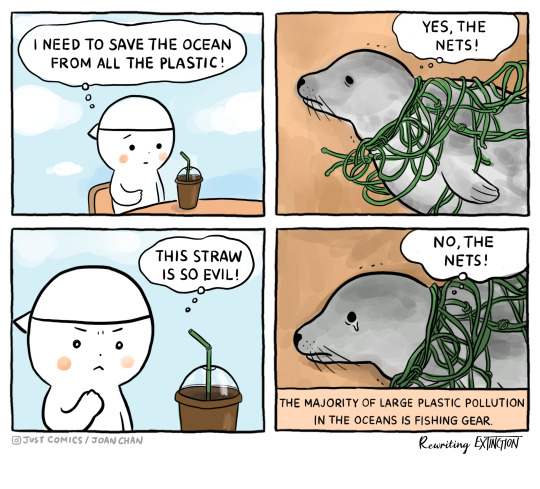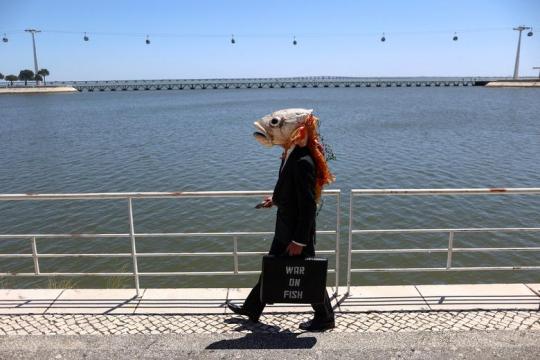#fishing industry
Text

AlterMidya on Twitter @altermidya:
LOOK: Filipino fisherfolks and environmental groups protest in front of the Netherlands embassy in Makati City today, March 22, to demand justice for what they call "grave corporate abuse" by Dutch dredging company Boskalis Westminster NV.
According to Kalikasan - People's Network for the Environment, the Dutch company is involved in several reclamation projects in the country such as the San Miguel Corporation's New Manila International Airport (NMIA) in Bulacan.
NMIA is considered by Boskalis as their "largest project in history."
“Boskalis is profiting from a project that bypassed environmental and social scrutiny, ignored warnings from impact assessments, and, worst, used military intimidation to coerce ‘consent’ from affected communities," said anti-reclamation activist Jhed Tamano.
The groups also seek accountability from the Dutch export credit agency Atradius Dutch State Business for supporting the construction of NMIA by providing export credit insurance valued at EUR 1.5 billion.
"We urge the Netherlands government to investigate corporate abuses by Dutch companies and -- until these abuses are thoroughly investigated -- to pressure the Philippine government to halt the airport project,” said Jonila Castro of Kalikasan.
Meanwhile, environmental advocates also protest in Papendrecht, Netherlands, where the Boskalis Westminster NV headquarters is located.
Photos by John Carlo Magallon
2024 Mar. 22
#no to land reclamation#philippines#corporate violence#netherlands#environmental issues#fishing industry#infrastructure#state violence#afp-pnp#overseas filipinos
61 notes
·
View notes
Text
The whole world is obsessed today with cutting down plastic straw consumption. But the reality of it is, that if you take all the straws around the world, and you put them all in the ocean, that is still less than a tenth of a percent (0.1%) of the plastic that goes into the ocean every year. In fact, more than 40% of all the plastic that goes into the ocean is plastic fishing nets.
- Vikas Garg in Let Us Be Heroes - The True Cost of Our Food Choices (2018)
#q#quotes#vikas garg#fishing industry#animal agriculture#earth stewardship#we are the ones we've been waiting for#plastic#pollution#sustainability#plant based lifestyle#veganism#food industry#holistic leveling up#leveling up#holistic health#that girl#green juice girl#green living#mindful consumption#mindful living#soft living#slow living#solarpunk#ecofeminism#eco#sidewalkchemistry
32 notes
·
View notes
Text
Image found on Pinterest.

6 notes
·
View notes
Text
3 notes
·
View notes
Text
Jellyfish Invasion Poses Threat to Southern Fishing Communities
Amidst the tranquil waters of southern Patharghta and Kuakata coasts in Barguna and Patuakhali, a looming threat to the fishing industry emerges—jellyfish. Fishermen find themselves increasingly deterred from venturing into the Bay of Bengal due to the proliferation of jellyfish populations.
The jellyfish species, identified as Phyllorhiza Punctata or white jellyfish, may lack toxicity but…

View On WordPress
2 notes
·
View notes
Note
Hi!
I was wondering if you were aware of the Plant-Based Treaty's campaign for octopuses, I think it's very important
https://www.drove.com/campaign/6202d5ca01cf365ea19492a3
i wasn't aware of the campaign. thank you for sharing!
for more context:
Previous attempts to breed octopuses for farming have faced high mortality rates among the animals, as well as cases of aggression, cannibalism and self-mutilation.
There's currently no recognised humane method to kill octopuses, and the current techniques used on wild octopuses are far from merciful to these cephalopods.
...
Growing demand for octopus is causing the overfishing of this animal, and subsequently the rise in its price on the global market. All of this is contributing to making the idea of farming octopuses increasingly more appealing.
...
In "The Case Against Octopus Farming" published on Issues in Science and Technology in 2019, researchers argue that "farming octopus is counterproductive from a perspective of environmental sustainability," as octopuses follow a carnivorous diet that will contain fishmeal.
According to the WWF, around a third of the global fish catch is used to feed other animals. Farming octopuses would just deepen the crisis experienced by depleted stocks.
With all that we know about the ongoing biodiversity crisis, animal welfare and the rise of vegan and vegetarian alternatives on the food market, choosing to farm octopuses seems, indeed, as scientists say, an unnecessary "disaster."
10 notes
·
View notes
Text

2022 Alexandria الإسكندرية
#2022#alexandria#egypt#beach#beachlife#boat#prototype#boat boys#yachtlife#yacht#skyscraper#fishing industry#fisherman#film photography#analog photography#120 film#middleformat#fujipro645#magazine#reporter#zappster#zapp_life#zappster_blog#noah inhauser#noahinhauser
3 notes
·
View notes
Text

The Town of Innsmouth is a small fishing port in east-central Massachusetts with a troubled history.
Founded during the Jacobean Era at the mouth of the Manuxet River, it grew gradually through the 18th century into a mercantile hub, at its height sending ships to ports throughout China, India, and the South Pacific Islands and developing a diverse local culture.
This resulted in occasionally violent social conflict with its neighbors in a very protestant and racist region of rural New England. In the 1840s a wave of hysteria swept through the surrounding towns due to a minor outbreak of fever, and the epidemic was blamed on Pacific immigrants which had married into local families during the previous decade. The economy was devastated by the destruction and rioting which followed, though the event is largely forgotten.
As the Asia-Pacific trade routes began to wane in the mid-19th century, the town contracted and returned to its traditional fishing, which itself faded into obsolescence due to the much larger industrial-scale operations out of the major cities.
The local land-owning elites which had grown rich during the age of mercantile sailing tried to reorient the town to light industry, finding some success in precious metals refinery due to their connections with the Malay gold trade from the late 18th century. At the same time, there was a resurgence of the Innsmouth fishing industry due to uncommonly rich yields throughout the late 19th century and into the 20th.
Around this time, the city embraced a peculiar local religious denomination centered around a pagan veneration of the sea and fishing, which emerged during the age of the Pacific trade out of the local masonic lodge and the maritime methodist and baptist churches. Its existence contributed to decades of animosity between Innsmouth and the surrounding region.
A small boom of new commercial development followed, and a branch railroad was built connecting Innsmouth to its inland neighbors formerly cut off due to the thick wetlands surrounding the Manuxet River. The streets were paved during this time and electric lighting was installed. The population began to grow as migrants from the south settled there to find work in the emerging industries surrounding the refineries and Innsmouth was nearly incorporated as a city.
A series of murders and bombings during the 1920s hit the community hard and many people were left homeless or fled, resulting in a persistent decline which continues to this day. Furthermore, Innsmouth was a center of rum smuggling and speakeasy culture during the Prohibition Era, and the town was dealt a harsh blow by a major FBI raid in 1927 which shut down the Marsh Gold Refinery due to extensive connections with the illegal liquor trade.
Innsmouth was left with very little commerce. All that remained were the unprofitable fishing industry and a tiny service economy centered on a grocery store, a few restaurants, bars which reopened following the repeal of prohibition, and a hotel. There are no colleges or high schools, and much of its youth has migrated elsewhere since the 1940s. The town's aging population currently stands at 1,173.
The Civic Flag of Innsmouth was designed in 1953 by 58 year old local resident Eber Gilman to celebrate the town's tricentennial that year, and was adopted officially in 1960. It reflects the area's mercantile history as well as its ubiquitous fishing culture and gradual revival.
On a blue field in the center of thirteen white stars it features a brigantine sailing ship with yellow banners, representing wealth and good fortune. Beneath the ship are three white cod emblematic of the fishing industry. Checkered against the three cod are three droplets of red blood, which represent the Revolutionary War, the War of 1812, and the American Civil War in which the town sent sailors to privateer and soldiers to enlist in the federal army.
Over the mast of the ship is a bright yellow droplet, which represents the historical gold refining industry, as well as the the bright yellow moonlight which shines over the harbor. The flag is 1:2 in aspect ratio, and the fly ends in a swallowtail which begins at the center-point. The upper tip of the swallowtail is colored yellow, representing gold and wealth, while the lower tip is in red, representing toil and struggle. Together they represent the dual nature of the town's heart.
Hopefully in the future more awareness will be directed at the plight of rural towns across the United States which have been in a slow process of death for the last two centuries due to the concentration of industry in the larger cities, leaving traditional sources of revenue obsolete and unprofitable. Innsmouth's story reflects a history of poverty, racism, loss, and perseverance which has shaped the American working class.
2 notes
·
View notes
Text

"CANADIAN CODFISH FULL OF VITAMINS," Toronto Star. November 3, 1943. Page 5.
---
This 50-pound codfish is a sample of what is being hauled out of the ocean these days by 3,000 Canadian fishermen who are working off Gaspe peninsula in an effort to supply the home market with cod liver oil that was formerly imported from Scandinavian countries. In addition to furnishing the vitamin-rich oil, the codfish are dried and salted and shipped overseas to Allied troops.
#gaspé#codfish#fishermen#fishing industry#war effort#feeding war#battle for food#canada in the british empire#histoire de quebec#canada during world war 2
1 note
·
View note
Text
Sperm Whale Full of Plastic
Fishing Gear Kills Sperm Whale
A sperm whale has been found dead on a beach in Hawaii, its body full of hundreds of pounds of ingested plastic waste.
Saturday, January 28th, a 56-foot sperm whale was found deceased on a reef of Kauai. Scientists, who rarely get to study the deep ocean predators, performed a necropsy there on the beach.
According to Kristi West, the director of the University of Hawaii’s Health and Stranding…

View On WordPress
#fishing industry#fishing waste#Hawaii#kristi west#microplastics#plastic waste#sperm whale#University of Hawaii
4 notes
·
View notes
Text
“Farmers need an urgent and concrete response from the government. Farmers need immediate aid, cash assistance, rice subsidies, and other short-term and long-term relief and rehabilitation efforts,” Ronnie Manalo, secretary general of Kilusang Magbubukid ng Pilipinas (KMP), said in a statement.
The El Niño affects 29,409 farmers and fisherfolk and 26,731 hectares of crops nationwide. “The total damage of El Niño in the country’s agriculture sector has reached almost P2 billion ($35.6B). Instead of help and assistance, the government offers credit and promises to the farmers and fisherfolks,” KMP said.
On March 19, Department of Agriculture (DA) Secretary Francis Tiu-Laurel said the agency would provide P379.06 million worth of assistance to farmers and fisherfolks affected by El Niño.
KMP Isabela and Bicol chapter reported that assistance from the government is poor. This is based on an impact assessment on El Niño in CALABARZON region conducted by volunteers.
Peasant women’s group AMIHAN emphasized the insufficient financial assistance for farmers who only received P3,000 ($53.41) to P5,000 ($89.02) despite high production cost of palay.
“The DA’s deception that they were addressing the effects and impact of El Niño adds to the neverending woes and suffering of farmers,” KMP said.
Cathy Estavillo, general secretary of Amihan, said that “The government’s move is essentially a deception because the farmers who already have heavy losses will be buried again in debt.”
“Based on social justice, the compensation for the farmers and fisherfolk is climate justice. It is not the first El Niño, but the government has repeatedly neglected agriculture and farmers. It becomes worse to the fact that the government is the initiator of the climate crisis in the country due to the expansion of land-use conversion, plantation, mining, logging, reclamation, and other activities that result in ecological imbalance. What the victims of El Niño need now is justice, not loans, and not insufficient financial assistance,” said Estavillo.
2024 Mar. 30
5 notes
·
View notes
Text
We, as human beings today, kill and consume a hundred billion land-based animals every year. That's more animals that we kill every year than all humans that have ever lived on Earth. If you start adding up the fish in the sea, that we take out of the sea every year, that's another two, two and half trillion. The United Nations Food and Agriculture Organization, the UNFAO, state that 90% of the world's fisheries are either fully exploited or overexploited. And, if current trends continue, then by 2048, the world's major fisheries will be gone.
- Vikas Garg & Peter Hammarstedt in Let Us Be Heroes - The True Cost of Our Food Choices (2018)
#q#quotes#vikas garg#peter hammarstedt#fishing industry#animal agriculture#earth stewardship#we are the ones we've been waiting for#sustainability#plant based lifestyle#veganism#food industry#holistic leveling up#leveling up#holistic health#that girl#green juice girl#green living#mindful consumption#mindful living#soft living#slow living#animal cruelty#animal liberation#speciesism#sidewalkchemistry
8 notes
·
View notes
Text
The outpost is intermittently frequented by members of Univaja, the Indigenous rights collective for whom [Bruno] Pereira had worked. But it is currently manned by a lone resident: a 76-year-old Peruvian named Juan da Silva and his black labrador mutt. Equipped with a torch, a fishing rod, a few cans of food and occasionally a radio, he fears for his life every night.
"I want to get out of here,” says Da Silva. “I don’t want to die. I want to live.”
The outpost is where [Dom] Phillips and Pereira slept the night before they were killed. Da Silva points to the hooks that held their hammocks, bolted to wooden posts under a small porch.
Pereira had slept on the right side of the building, which overlooks a small estuary used by illegal fisherman to enter a lake with thousands of valuable pirarucu fish – and a pathway into Indigenous land that evades a government checkpoint a few miles upstream.
"The fishermen get very angry if we don’t let them through,” Da Silva says, pointing to the stream, where a shaggy crested Amazon kingfisher sits on a branch scouring the water. “Sometimes I can’t stop them, because if I did they would kill me.”
Such are the contrasts in this underreported part of the Amazon rainforest where magnificent natural beauty has become a backdrop to increasing violence and impunity. It is the setting for a battle over access to resources that has intensified following the election of Brazil’s far-right president, Jair Bolsonaro, in 2018.
Law enforcement officials say the Javari Valley, an area the size of Portugal and home to the world’s largest concentration of uncontacted Indigenous tribes, is now Brazil’s second largest drug trafficking route, where the interwoven illicit industries of fishing, logging and mining have proliferated over the past decade.
Pereira had worked with villagers here, trying to steer them away from illegal fishing – many of the river’s species are subject to strict regulation to manage stocks, and it is prohibited to fish in Indigenous territory further upstream. But a single pirarucu, one of the world’s largest freshwater fish, which grows to over 100 kilograms, can be sold for $1,000 at market price, while a single Amazon river turtle can be sold for $200.
Locals say illegal activities have become commonplace in recent years. One villager recently spotted a boat with three men carrying shotguns, laden with illegally caught fish. Illegal fishermen use small boats, laden with ice, to navigate into Indigenous land under cover of darkness, according to a report by Univaja, and then return to deliver their catches to larger boats waiting on the main river.
#amazon rainforest#indigenous rights#dom phillips#bruno pereira#fishing#fishing industry#illegal fishing#jair bolsonaro#logging#illegal logging#environment#Brazil
6 notes
·
View notes
Text

Don't get it twisted!
50% of ocean plastic comes from, you guessed it, fishing nets! Fishing equipment discarded by the fishing industry is left to slowly break down and fill our oceans with microplastics.
These nets are not only highly pollutant, they also bring great harm to marine wildlife, who can get trapped in and suffocated by abandoned gear.
Reducing our plastic pollution as consumers is highly important, but large industries need to take responsibility for their waste and their environmental impact.
Don't let them shift the blame.
TheJustComics
3 notes
·
View notes
Text

An activist with Ocean Rebellion walks to take part in a protest outside the UN Ocean Conference against what they describe as a "war on fish", in Lisbon, Portugal June 27.
REUTERS/Pedro Nunes
2 notes
·
View notes
Video
youtube
Tuna, Tech, and Ocean Communities with Bubba Cook
#youtube#Tuna Fishing#Ocean Conservation#Sustainable Fishing#Fishing Technology#Ocean Communities#Bubba Cook#Seafood Sustainability#Fishing Industry
0 notes